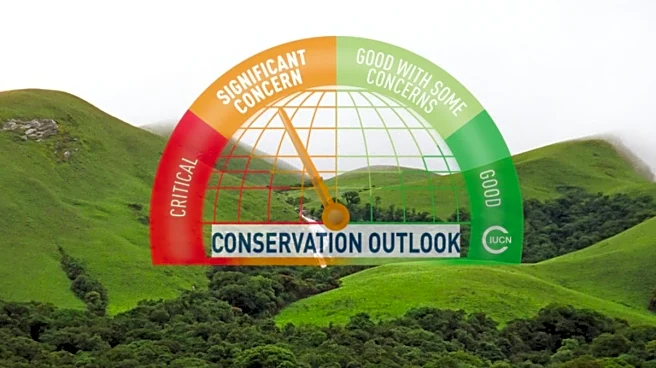The Western Ghats, a majestic mountain range spanning over 1,600 kilometres along India’s western coast across six states—Gujarat, Maharashtra, Goa, Karnataka, Tamil Nadu, and Kerala—is a global biodiversity
hotspot. Recognised as a UNESCO natural World Heritage Site, this ecological gem is vital for its rich ecosystems and unique species, yet it faces growing threats that demand attention.
However, the International Union for Conservation of Nature (IUCN) has classified the Western Ghats and two Indian national parks—Manas Wildlife Sanctuary and Sundarbans National Park—as areas of “significant concern” in its World Heritage Outlook 4 report, highlighting urgent conservation challenges.
Its inclusion on the IUCN watchlist signals serious threats to its survival. Let’s understand why the Western Ghats are at risk and why their preservation is important.
What Are the Western Ghats?
The Western Ghats, often called the “Great Escarpment of India,” are older than the Himalayas, formed over 150 million years ago. This ancient range is a biodiversity hotspot, hosting an estimated 7400 plant species, 139 mammal species, 508 bird species, 179 amphibian species, and countless invertebrates, many of which are endemic (found nowhere else on Earth).
According to the Botanical Survey of India, nearly 1500 plant species in the region are unique. The Ghats also serve as the origin for major rivers like the Godavari, Krishna, and Kaveri, which sustain millions of livelihoods through agriculture, fishing, and drinking water.
Beyond its ecological role, the Western Ghats influence India’s monsoon patterns, acting as a barrier that intercepts moisture-laden winds, ensuring rainfall for vast swathes of the subcontinent.
The region’s forests also sequester carbon, mitigating climate change, and its indigenous communities, such as the Todas and Soligas, rely on its ecosystems for their cultural and economic survival.
Why Are the Western Ghats on IUCN’s Watchlist?
The IUCN, a global authority on species and ecosystem conservation, places sites on its watchlist when they face significant threats that could degrade their ecological integrity. The Western Ghats earned this designation due to a combination of human-induced pressures that jeopardise its biodiversity and functionality.
Here are the key reasons, based on reports from organisations like the Ashoka Trust for Research in Ecology and the Environment (ATREE) and the Ministry of Environment, Forest and Climate Change (MoEFCC):
Deforestation and Habitat Loss: Rapid urbanisation, agricultural expansion, and infrastructure projects have led to significant deforestation. A 2023 study by ATREE estimated that the Western Ghats lost approximately 5% of its forest cover between 1985 and 2020. Activities like tea, coffee, and rubber plantations, as well as illegal logging, have fragmented habitats, threatening species like the lion-tailed macaque and the Malabar civet.
Mining and Industrial Activities: Unregulated mining for iron ore, bauxite, and other minerals has scarred the landscape, particularly in states like Goa and Karnataka. The Central Empowered Committee, appointed by India’s Supreme Court, reported in 2022 that illegal mining in the Ghats has polluted rivers and disrupted ecosystems, endangering aquatic species and downstream communities.
Climate Change: Rising temperatures and erratic rainfall patterns are altering the Ghats’ delicate ecosystems. A 2024 report by the Indian Institute of Science (IISc) highlighted that climate change is shifting the distribution of endemic species, with some high-altitude plants and animals moving upward, only to face shrinking habitats.
Extreme weather events, like the 2018 Kerala floods, have also caused landslides, further destabilising the region.
Invasive Species and Pollution: Non-native plants like eucalyptus and lantana have invaded the Ghats, outcompeting native flora. Pollution from industrial effluents and agricultural runoff has degraded water quality in rivers originating from the Ghats, affecting both wildlife and human populations. The Central Pollution Control Board noted in 2023 that several river stretches in the region are critically polluted.
Human-Wildlife Conflict: As human settlements encroach on forest areas, conflicts with wildlife, such as elephants and leopards, have increased. The Wildlife Protection Society of India reported over 200 human-wildlife conflict incidents in the Western Ghats in 2024 alone, often resulting in harm to both animals and people.
The IUCN’s watchlist status reflects these cumulative threats, signalling that without urgent action, the Western Ghats could lose its World Heritage status and, more critically, its ability to sustain biodiversity and human livelihoods.
Why Should You Care?
The Western Ghats’ decline is not just a regional issue; it has far-reaching implications. Here’s why everyone, from local communities to global citizens, should care:
Global biodiversity at stake: The Western Ghats are one of only 36 global biodiversity hotspots, as recognised by Conservation International. Losing species here—such as the critically endangered Nilgiri tahr or the Malabar gliding frog—reduces the planet’s genetic diversity, weakening ecosystems’ resilience to global challenges like climate change.
Water security for millions: Over 245 million people depend on rivers originating in the Western Ghats. Degradation of these watersheds threatens water availability for drinking, irrigation, and hydropower. For instance, the Kaveri River, vital for Tamil Nadu and Karnataka, is already under stress due to reduced forest cover, as noted in a 2023 MoEFCC report.
Climate regulation: The Ghats’ forests act as carbon sinks, absorbing greenhouse gases. Their destruction accelerates climate change, affecting global weather patterns. Protecting these forests aligns with international climate goals, such as those outlined in the Paris Agreement.
Economic and cultural impacts: The region supports industries like tourism, agriculture, and fisheries, which employ millions. For example, the tea estates of Munnar and coffee plantations of Coorg rely on the Ghats’ climate and soil. Indigenous communities also face cultural erosion if their ancestral lands are degraded, as highlighted by the National Centre for Biological Sciences in 2024.
A global responsibility: As a UNESCO World Heritage Site, the Western Ghats belong to humanity’s shared heritage. Their preservation is a collective responsibility, especially for nations committed to the UN’s Sustainable Development Goals, which emphasise biodiversity and ecosystem protection.
What Can Be Done?
The Western Ghats’ place on the IUCN’s watchlist is a wake-up call. This ancient, vibrant ecosystem is under siege from deforestation, mining, climate change, and more. Its preservation is not just about saving a mountain range; it is about securing water, food, and climate stability for millions while protecting a global biodiversity treasure.
By understanding the threats and supporting conservation efforts, we can ensure the Western Ghats continue to thrive as a lifeline for India and a heritage for the world. Your awareness and actions matter because losing the Western Ghats would be a loss for us all.
Efforts to save the Western Ghats are underway, but they need broader support. The Western Ghats Ecology Expert Panel (WGEEP), led by Madhav Gadgil, recommended in 2011 that large parts of the Ghats be declared ecologically sensitive areas (ESAs) to restrict destructive activities. While some areas have been notified as ESAs by the MoEFCC, implementation remains patchy.


/images/ppid_a911dc6a-image-176136743792665664.webp)

/images/ppid_59c68470-image-176147503007945224.webp)











